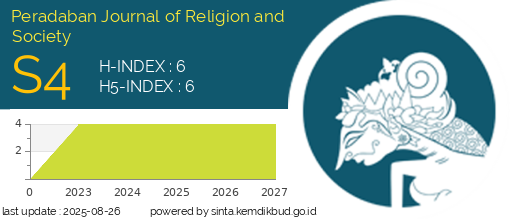Religion, Media and Peacebuilding
How does Buddhist TV Promote Harmony between Religious Followers in Malang
DOI:
https://doi.org/10.59001/pjrs.v1i1.29Keywords:
Media, Peacebuilding, Dhamma TV, Harmony, , Buddhist TV, Religious TelevionAbstract
This article aims to examine the role and efforts of Dhamma TV, a Buddhist-based television station in Malang City, in building peace and harmony between religious communities. The study also shows the normative-theological construction that underlies these efforts. Because religion and media have great potential for peacebuilding. However, both can also be an obstacle to peace. Thus, religion-based media that consistently strives for harmony and peace become a significant aspect of a pluralistic society. This study found that Dhamma TV is a religion-based media that consistently broadcasts programs that contain the values of togetherness, tolerance, and peace. Television avoids programs that contain violence and have the potential to break the unity and harmony of society. Dhamma TV commonly presents cultural programs and social activities from various religions, so it is considered a medium for interfaith adhesives. The effort to build peace and harmony between religious communities is an expression and implementation of Buddhist teachings. Buddhism emphasizes mutual love and kindness to all living beings. In addition, Buddha emphasizes valuing and respecting the lives of others as his own as well.
References
Abu-Nimer, M. (2010). Nonviolence and Peace-building in Islam: Theory and Practice . Jakarta: Alphabet Library.
Abu-Nimer, M., & Nasser, I. (2017). Building peace education in the Islamic educational context. International Review of Education , 63 (2), 153-167. https://doi.org/10.1007/s11159-017-9632-7
Alfian. (1999). Socio-Cultural Transformation in National Development . Jakarta: University of Indonesia.
Armando, A. (2011). Television Jakarta over Indonesia: The Story of the Failure of the Networked Television System in Indonesia . Library Landscape.
Betz, M., & Williams, K. (2007). How media can be an instrument of peace in conflict settings . Oslo.
BPS, BPS (2010). 2010 Population Census-Population by Region and Religion | East Java Province. Retrieved July 12, 2022, from Www.bps.go.id website: http://sp2010.bps.go.id/index.php/site/tabel?tid=321&wid=3500000000
Bratic, V., & Schirch, L. (2009). Why and When to Use the Media for Conflict Prevention and Peacebuilding . Global Partnership for the Prevention of Armed Conflict. Retrieved from the Global Partnership for the Prevention of Armed Conflict website: https://gsdrc.org/document-library/why-and-when-to-use-the-media-for-conflict-prevention-and-peacebuilding/, https http://gsdrc.org/document-library/why-and-when-to-use-the-media-for-conflict-prevention-and-peacebuilding/
Dhammananda. (2004). Buddhist Faith (I. Kurniati, Trans.). Jakarta: Karaniya Energy Foundation.
Dhammasugiri. (2004). The Concept of Love in Buddhism. Dhammacakka Magazine .
Gopin, M. (2000). Between Eden and Armageddon . Oxford: Oxford University Press.
Heneghan, T. (2012, December 18). "No religion" third world group after Christians, Muslims. Reuters . Retrieved from https://www.reuters.com/article/us-religion-world-idUSBRE8BH0KG20121218
Horsfield, PG (1984). Religious Television: The American Experience . New York: Longman Publishing Group.
Idris, I. (2020). Media/communications for peacebuilding/social cohesion/changing prevailing narratives on conflict . Brighton, UK: Institute of Development Studies.
Johnston, D., & Sampson, C. (Eds.). (1995). Religion, The Missing Dimension of Statecraft (1st edition). New York: Oxford University Press.
Kimball, C. (2003). When religion is a disaster: Charles, Kimball . Bandung: Mizan.
McQuail, D. (1991). Mass Communication Theory (A. Dharmawan & A. Ram, Trans.). Bandung: Erlangga Publisher.
Norman, KR (2004). The Word of the Doctrine (Dhammapada) . Oxford: The Pali Text Society.
Shamsu. (2019, May). Dhamma TV Production Manager Interview .




